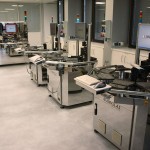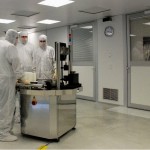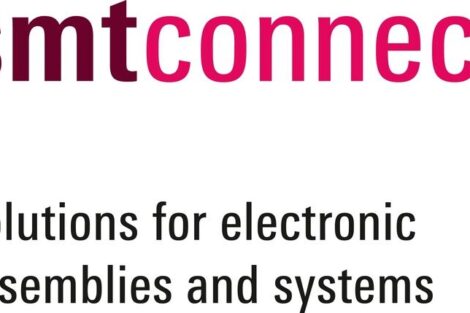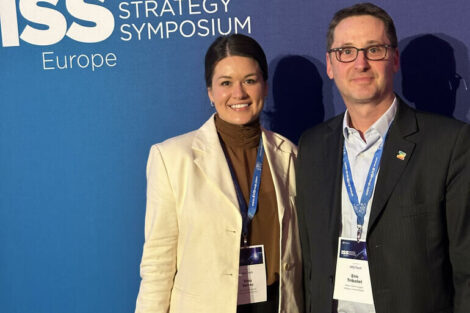The ever-changing tasks from the wide and differentiated range of applications found in the field of semiconductor industries demand customized basic raw materials for the individual underlying wafers. Thereby the spectrum ranges from very massive materials up to semitransparent materials. In the same way the requirements in flexibility, processing speed, and reliability of production systems for this small disks will increase. InnoLas Semiconductor GmbH succeeded with a new concept, to optimally align the approved Sorter IL 2600 for future production processes.
Innolas Semiconductor, Krailling (Germany)
The electronic products we use in our daily lives make an ever increasing use of semiconductors. For example microprocessors, digital memory, lasers in CD/DVD players or the latest trend using energy efficient LEDs in automobiles and for lighting purposes. Previously the industry used primarily silicon wafers which dominated the market but nowadays there are an increasing number of other materials being used. According to the product required these materials are processed into various sizes of wafers and to maintain the quality and consistency of the end product these have to be marked and sorted. One of the active participants in this sector is the the company from Krailling near Munch which is a worldwide recognised specialist for wafer marking and sorting systems.
Opportunely to new requirements of the semiconductor and LED wafer industry the development team took the already proven IL 2600, the sorter for 2 inch to 200 mm wafers, and rejuvenated it. While the small eight-sided outline (approximately 1.3 x 1.4 m) remained the same, throughput was significantly raised. The system processes more than 300 wafers an hour including wafer alignment wafer thickness measurement and automatic reading of the wafer ID. By a simple transfer from cassette to cassette over 800 wafers per hour can be achieved.
High flexibility
The wide range of materials requires a highly flexible system. The sorter offers the possibility of using several reading systems. Depending of the configuration it is possible to read markings on the underside, the topside or both sides of the wafer. Apart from industry-standard silicon wafers the system can for example process gallium arsenide (GaAs) wafers or even semi-transparent materials. It is here where many other systems reach their limits. Wafers of GaAs are relatively heavy, thus requiring stable and robust support by the robot, which must itself be of light construction as this would otherwise reduce the throughput. The problem with semi-transparent wafers is the identification of the edge of the wafer, whereby a relatively complex process is required. “With the rejuvenation of the IL 2600 we have solved both tasks optimally”, enthuses the Head of Sales and Technology Specialist Michael Siebert. “Our customers can trust that their innovative wafer products will be processed even better than before.”
Regarding operation further improvements have been made. The team have integrated a new Drag-n-Drop mode into the software. This enables the user to transfer a self-selected number of wafers with the graphic user interface on the newly introduced 19-inch monitor to another cassette. The sorter then carries this out automatically on command. Furthermore the freshly configured recipe editor is easier to use. “We have placed great emphasis on clarity and self-explanatory sequences” Head of Development Sven Wollstadt explains this additional step. “The employees in the cleanroom are under pressure. When a system is simpler to operate it will be safer and quicker in operation.”
Ease of use results in high reliability
With reference to safety the sorter offers a further feature: the railing around the cassette loading stations. This protects the cassettes against possible impacts or vibration, emanating from the immediate vicinity of the system. This is especially worthwhile for the small machine which can be placed anywhere in the cleanroom, directly on a wall or in free floor space.
The modularity, a major advantage of the system, remains an integral part of it. Beside the various reader systems the machine can be equipped with up to six carrier stations for wafer sizes from 2 to 8 inch. Then it is irrelevant how many stations the system was ordered with, it can always be converted. Each station recognises the wafer size of the cassette placed on it. So as an operator places a cassette on a station and selects a recipe, the system knows if a mistake has been made and gives an appropriate error message. If the wrong wafer size or the wrong station has been used the process cannot start until the mistake is corrected. The recipe can also be sent via the host computer. The connection and the complete remote control by a host is offered by the integrated GEM interface. Last but not least the system can be equipped with the new wafer thickness measurement solution.
Andreas Behr, General Manager of the company sums up the tuning measures: “With the improvements for the wafer sorting system we have satisfied the essential wishes of our customers and the perspective of the market. Thereby we have a system which fulfils our customers’ requirements and is also ready for new technologies.” Of course this system also fulfils the general SEMI Standards for the production of wafers in the semiconductor industry.
ZUSAMMENFASSUNG
Differenzierte Anwendungen in der Halbleiterbranche erfordern immer neue Ausgangsmaterialien bei den zu Grunde liegenden Wafern. In gleichem Maße steigen die Anforderungen an Flexibilität, Geschwindigkeit und Zuverlässigkeit bei den Produktionsanlagen für die kleinen Scheiben. Mit einem geeigneten Konzept konnte ein bereits bewährter Sortierer auf die künftigen Verarbeitungsprozesse abgestimmt werden.
Les applications différenciées dans la branche des semi-conducteurs nécessitent constamment de nouveaux matériaux base pour les composants. Les exigences de flexibilité, de vitesse et de fiabilité pour les installations de production des petits disques croissent dans la même proportion. Grâce à un concept approprié, une trieuse qui a déjà fait ses preuves a pu être ajustée aux futurs processus de travail.
Share:













